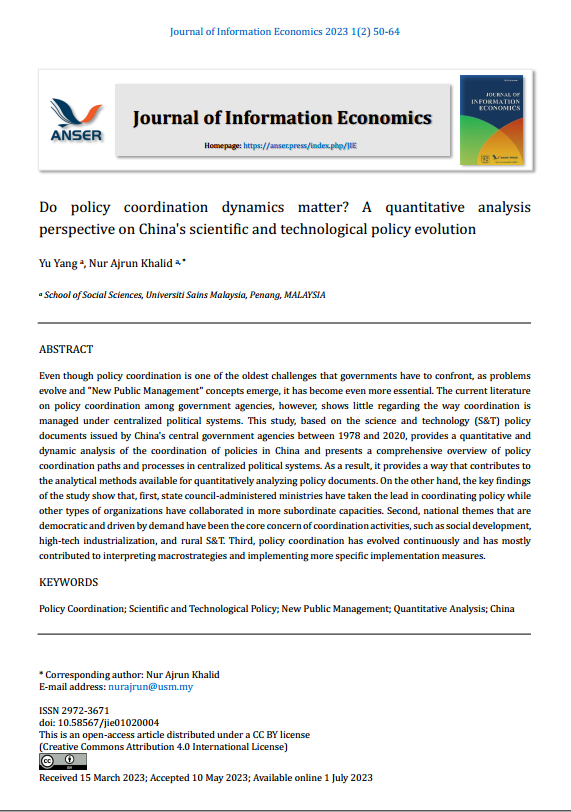Do policy coordination dynamics matter? A quantitative analysis perspective on China's scientific and technological policy evolution
DOI:
https://doi.org/10.58567/jie01020004Keywords:
Policy coordination, Scientific and technological policy, New public management, Quantitative analysis, ChinaAbstract
Even though policy coordination is one of the oldest challenges that governments have to confront, as problems evolve and "New Public Management" concepts emerge, it has become even more essential. The current literature on policy coordination among government agencies, however, shows little regarding the way coordination is managed under centralized political systems. This study, based on the science and technology (S&T) policy documents issued by China's central government agencies between 1978 and 2020, provides a quantitative and dynamic analysis of the coordination of policies in China and presents a comprehensive overview of policy coordination paths and processes in centralized political systems. As a result, it provides a way that contributes to the analytical methods available for quantitatively analyzing policy documents. On the other hand, the key findings of the study show that, first, state council-administered ministries have taken the lead in coordinating policy while other types of organizations have collaborated in more subordinate capacities. Second, national themes that are democratic and driven by demand have been the core concern of coordination activities, such as social development, high-tech industrialization, and rural S&T. Third, policy coordination has evolved continuously and has mostly contributed to interpreting macrostrategies and implementing more specific implementation measures.
References
Alexander, E. R. (1993). Interorganizational Coordination: Theory and Practice. Journal of Planning Literature, 7(4), 328–343. https://doi.org/10.1177/088541229300700403
Appelbaum, R., Gebbie, M., Han, X., Stocking, G., & Kay, L. (2016). Will China’s quest for indigenous innovation succeed? Some lessons from nanotechnology. Technology in Society, 46. https://doi.org/10.1016/j.techsoc.2016.03.004
Aria, M., & Cuccurullo, C. (2017). bibliometrix: An R-tool for comprehensive science mapping analysis. Journal of Informetrics, 11(4), 959–975. https://doi.org/10.1016/j.joi.2017.08.007
Boston, J. (2005). The Problems of Policy Coordination: The New Zealand Experience. Governance, 5, 88–103. https://doi.org/10.1111/j.1468-0491.1992.tb00030.x
Bouckaert, G., Peters, B. G., & Verhoest, K. (2010). The Coordination of Public Sector Organizations. Palgrave Macmillan UK. https://doi.org/10.1057/9780230275256
Cao, C., Li, N., Li, X., & Liu, L. (2013). Reforming China’s S&T system. Science, 341, 460–462. https://doi.org/10.2307/23491185
Dawes, S. S., & Janssen, M. (2013). Policy informatics: Addressing complex problems with rich data, computational tools, and stakeholder engagement. Proceedings of the 14th Annual International Conference on Digital Government Research, 251–253. https://doi.org/10.1145/2479724.2479759
Desai, A., & Kim, Y. (2015). Symposium on Policy Informatics. Journal of Policy Analysis and Management, 34. https://doi.org/10.1002/pam.21823
Flanagan, K., Uyarra, E., & Laranja, M. (2011). Reconceptualising the ‘policy mix’ for innovation. Research Policy, 40(5), 702–713. https://doi.org/10.1016/j.respol.2011.02.005
Gao, Z., & Tisdell, C. (2003). China’s Reformed Science and Technology System: An Overview and Assessment. University of Queensland, School of Economics, Economic Theory, Applications and Issues Working Papers, 22. https://doi.org/10.1080/0810902042000255741
Goyal, N. (2017). A “review” of policy sciences: Bibliometric analysis of authors, references, and topics during 1970–2017. Policy Sciences, 50(4), 527–537. https://doi.org/10.1007/s11077-017-9300-6
Griessen, T., & Braun, D. (2008). The political coordination of knowledge and innovation policies in Switzerland. Science & Public Policy - SCI PUBLIC POLICY, 35, 277–288. https://doi.org/10.3152/030234208X310338
Hagen, L., Harrison, T., Uzuner, O., Fake, T., LaManna, D., & Korfila, C. (2015,). Introducing Textual Analysis Tools for Policy Informatics: A Case Study of E-petitions.
Hagen, L., Keller, T., Zhao, X., & Luna-Reyes, L. (2019). Open data visualizations and analytics as tools for policy-making. Government Information Quarterly, 36. https://doi.org/10.1016/j.giq.2019.06.004
Hagen, N. (2010). Harmonic publication and citation counting: Sharing authorship credit equitably - not equally, geometrically or arithmetically. Scientometrics, 84, 785–793. https://doi.org/10.1007/s11192-009-0129-4
Hatmaker, D. M., Park, H. H., & Rethemeyer, R. K. (2011). Learning the Ropes: Communities of Practice and Social Networks in the Public Sector. International Public Management Journal, 14(4), 395–419. https://doi.org/10.1080/10967494.2011.656051
Huang, C., Yang, C., & Su, J. (2018). Policy change analysis based on “policy target–policy instrument” patterns: A case study of China’s nuclear energy policy. Scientometrics, 117, 1–34. https://doi.org/10.1007/s11192-018-2899-z
Johnston, E. (2011). Introduction to the Special Issue on Policy Informatics. 16.
Newman, M. E. J. (2001). Scientific collaboration networks. I. Network construction and fundamental results. Physical review. E, Statistical, nonlinear, and soft matter physics, 64, 016131. https://doi.org/10.1103/PhysRevE.64.016131
Newman, M. E. J. (2004). Analysis of weighted networks. Physical Review E, 70(5), 056131. https://doi.org/10.1103/PhysRevE.70.056131
Painter, M. (2008). Central Agencies and the Coordination Principle. Australian Journal of Public Administration, 40, 265–280. https://doi.org/10.1111/j.1467-8500.1981.tb00519.x
Peters, B. G. (2018). The challenge of policy coordination. Policy Design and Practice, 1(1), 1–11. https://doi.org/10.1080/25741292.2018.1437946
Rondinelli, D. A., Nellis, J. R., & Cheema, G. S. (1983). Decentralization in developing countries: A review of recent experience. World Bank.
Sivertsen, G., Rousseau, R., & Zhang, L. (2019). Measuring scientific contributions with modified fractional counting. Journal of Informetrics, 13, 679–694. https://doi.org/10.1016/j.joi.2019.03.010
Sun, Y., & Cao, C. (2018). The evolving relations between government agencies of innovation policymaking in emerging economies: A policy network approach and its application to the Chinese case. Research Policy, 47. https://doi.org/10.1016/j.respol.2018.01.003
Tamtik, M. (2016). Policy coordination challenges in governments’ innovation policy—The case of Ontario, Canada. Science and Public Policy, 44. https://doi.org/10.1093/scipol/scw074
Tosun, J., & Lang, A. (2017). Policy integration: Mapping the different concepts. Policy Studies, 38(6), 553–570. https://doi.org/10.1080/01442872.2017.1339239
Trein, P., Meyer, I., & Maggetti, M. (2018). The Integration and Coordination of Public Policies: A Systematic Comparative Review. Journal of Comparative Policy Analysis Research and Practice, 21. https://doi.org/10.1080/13876988.2018.1496667
Xiang, J., & Ma, F. (2021). Government agencies and their roles in the diffusion of intellectual property policy in China: Analysis based on a policy literature reference network. International Review of Administrative Sciences, 87(4), 888–907. https://doi.org/10.1177/0020852319877940
Zheng, H., Jong, W. M., & Koppenjan, J. (2010). Applying Policy Network Theory to Policy-Making in China: The Case of Urban Health Insurance Reform. Public administration, 88, 398–417. https://doi.org/10.1111/j.1467-9299.2010.01822.x
Zhou, L.-A. (2016). The administrative subcontract: Significance, relevance and implications for intergovernmental relations in China. Chinese Journal of Sociology, 2(1), 34–74. https://doi.org/10.1177/2057150X15622376

Downloads
Published
How to Cite
Issue
Section
License
Copyright (c) 2023 Yu Yang, Nur Ajrun Khalid

This work is licensed under a Creative Commons Attribution 4.0 International License.
